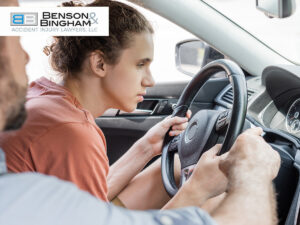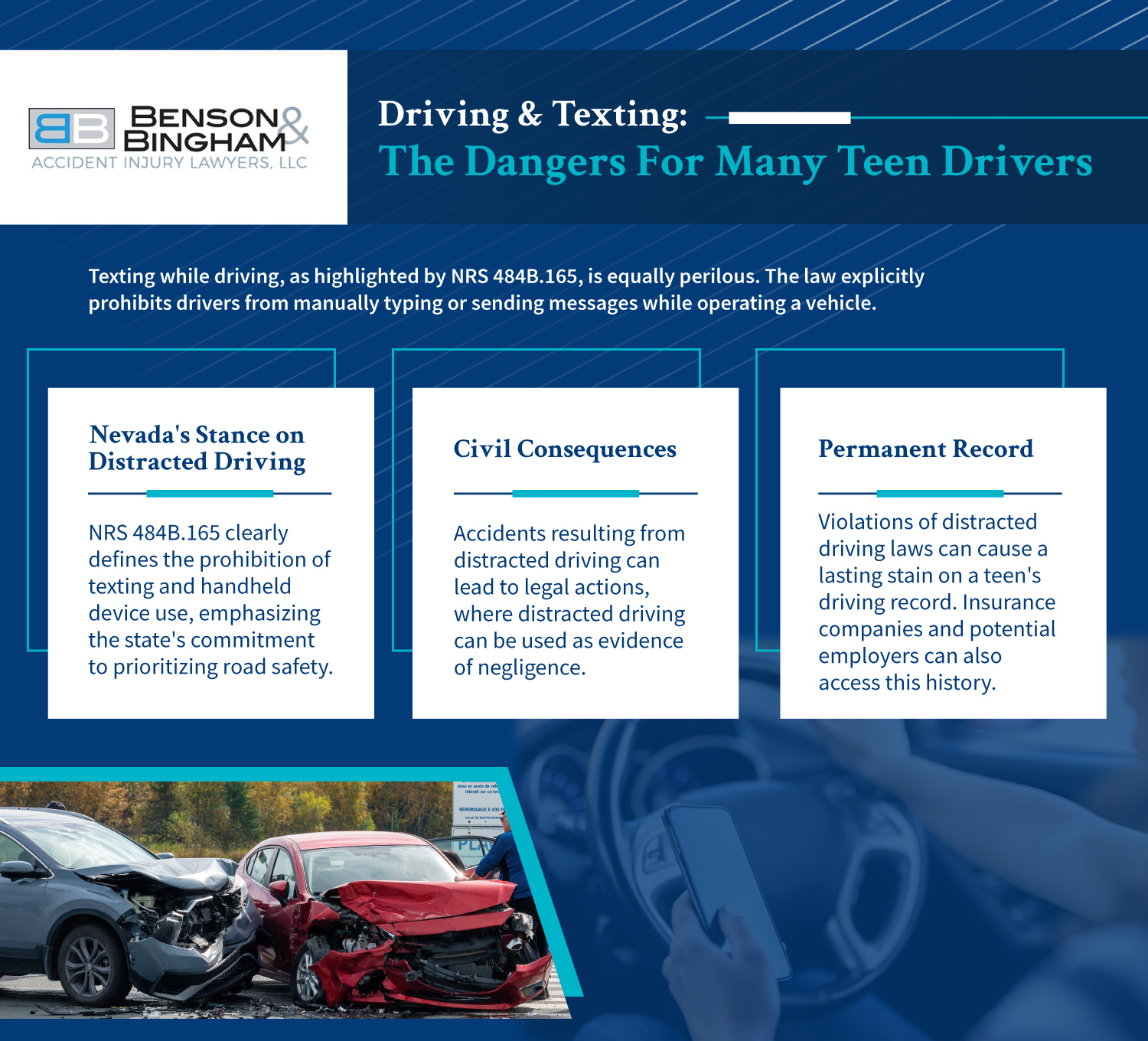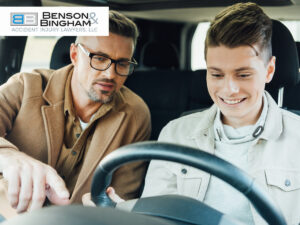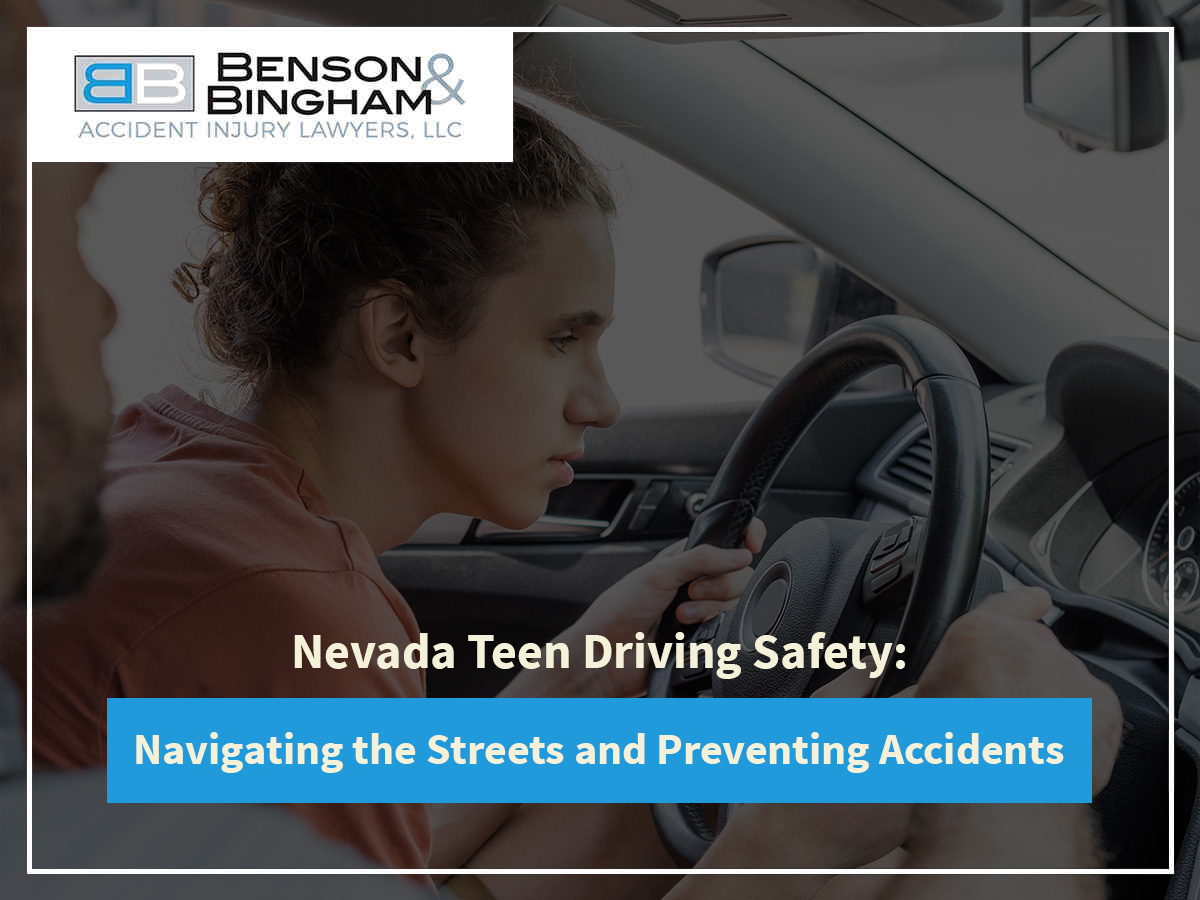Ensuring Teen Safe Driving & Understanding the Nevada Law
Learning to drive and getting a driver’s license is a rite of passage for many teenagers in Nevada. However, for many parents, teen driving is worrisome, especially when their children have access to distractions at their fingertips. This year, Nevada saw several car accidents where teen drivers were involved. This leads one to ask the question: What is the correlation between teen drivers and car accidents?
Motor vehicle accidents, primarily car accidents, remain the number one cause for death of teenagers in the United States. Vehicular accidents take away the lives of 2,400 lives annually in the United States and fifty percent of teens will be in a car accident before graduating high school.
The Legal Age & Driving

Upon reaching 16 years of age, teenagers can graduate to a full driver’s license, as defined by NRS 483.160. This signifies successful completion of a road skills test and the attainment of a substantial level of driving experience. By adhering to these legal age requirements, teenagers embark on their driving journey with the necessary foundation of knowledge and experience.
Parents, Guardians, & Legal Implications
Nevada’s approach to teenage driving extends beyond the teenagers themselves; parents and guardians play a pivotal role in shaping responsible drivers. NRS 483.302 emphasizes the joint liability of parents or legal guardians in case a minor is found liable for an accident. This legal framework underscores the shared responsibility between parents and teenagers in promoting safe driving practices.
The law further dictates that the joint liability of parents or legal guardians may not exceed $20,000 for injuries and $10,000 for property damage. However, these limits can be exceeded if the minor driver was operating a vehicle in the course of their employment.
The Recent Surge in Pedestrian Accidents Involving Teenagers
Teens, while constituting only 5% of drivers on Nevada roadways, account for a disproportionately high 10% of crashes. This discrepancy underscores a concerning trend in the state’s accident statistics. Delving deeper, data from Zero Teen Fatalities Program reveals that distracted driving is a significant factor in these accidents.
Teenage drivers under 20 are the largest group distracted at the time of fatal crashes. In particular, the use of cell phones while driving is a major concern, as it leads to a significant 37% reduction in brain activity. Such distractions compromise a driver’s focus, posing a considerable risk to both themselves and pedestrians sharing the road. These statistics underscore the urgent need for comprehensive interventions to address the surge in pedestrian accidents involving teenagers.
Understanding Liability & Legal Outcomes of Teen Driver Car Accidents in Nevada
Nevada’s roads see a mix of experienced and novice drivers, with teens being a notable segment of the latter. Teen drivers, given their limited experience, may sometimes make impulsive decisions on the road, which can lead to accidents. It’s crucial for both teens and their guardians to understand the legal implications that come with such incidents in Nevada.
- Fault-Based System: If a teen causes an accident, they (and potentially their guardians) bear the financial responsibilities (NRS 41.130).
- Insurance: All drivers, teens included, must have Nevada’s minimum liability insurance (NRS 485.185).
- Comparative Negligence: If a teen is partly at fault in an accident, their claimable compensation decreases by their fault percentage (NRS 41.141).
- Parental Liability: Parents may be financially liable if their teen causes an accident (NRS 41.470).
- License Restrictions: Teens have specific license conditions. Violations can lead to penalties and impact liability (NRS 483.2521).

Driving & Texting: The Dangers For Many Teen Drivers
Among the foremost concerns for teenage drivers are the dangers of speeding and texting while driving. The National Highway Traffic Safety Administration (NHTSA) mentions cell phone use as a contributing factor in a substantial portion of accidents involving young drivers.
Texting while driving, as highlighted by NRS 484B.165, is equally perilous. The law explicitly prohibits drivers from manually typing or sending messages while operating a vehicle. Understanding these laws not only ensures compliance but also instills a deep appreciation for the potentially devastating consequences of these actions.
Nevada’s Stance on Distracted Driving
Nevada’s stance on distracted driving is resolute. NRS 484B.165 clearly defines the prohibition of texting and handheld device use, emphasizing the state’s commitment to prioritizing road safety.
Civil Consequences
Beyond fines, there are civil consequences for distracted driving. Accidents resulting from distracted driving can lead to legal actions, where distracted driving can be used as evidence of negligence.
Permanent Record
Violations of distracted driving laws can result in a lasting stain on a teenager’s driving record. This record is not only accessible to insurance companies but also potential employers, highlighting the enduring impact of these actions.
Shaping Better Drivers: Educating Our Teens
Empowering teenagers with knowledge is paramount to shaping responsible drivers. Parents can take an active role in this endeavor by imparting crucial lessons that go beyond driving skills. These lessons are supported by NRS provisions and aim to instill a mindset of safety and responsibility.
Things Parents Can Teach Their Teens to Help Prevent Car Accidents
If parents choose to allow their teen to drive, they should consider implementing the following rules to ensure their child’s safety:
- Parents should not allow young drivers unrestricted driving privileges until they have gained sufficient experience.
- Parents should limit their teen’s driving alone in adverse weather conditions (rain, snow, ice, fog, etc.) and at night until the teen has sufficient skills and experience.
- Parents must remind teens that driving under the influence of alcohol or drugs is illegal and dangerous and should be strictly prohibited.
- Parents should work out when and where the teen is allowed to drive the car (e.g. to and from part-time job, etc.).
- Everyone in the car must wear seat belts at all times.
- Parents should determine whether and when their teen can drive passengers. Nevada does not allow teens to drive non-related passengers until six months after obtaining their driver’s license.
- Parents should determine what behavior or circumstances will result in loss of the teen’s driving privileges.
- Teens should not drive when fatigued or tired.
- Headphones should never be worn while driving.
- Teens should not text or talk on the phone while driving.
- Helmets must be worn when riding a motorcycle.
- Teens should be encouraged to take an annual defensive driving course after obtaining their license.

Safest Cars for Teenage Drivers In 2023
The safety of teenage drivers is profoundly influenced by the vehicles they operate. Understanding vehicle safety ratings and features can guide parents in selecting the most suitable car for their teenagers.
According to the Insurance Institute for Highway Safety, the following models are standout options for teenage drivers in 2023:
- Mazda 3
- Subaru Legacy
- Honda HR-V
- Subaru Ascent
- Honda Odyssey
The Role Of An Experienced Personal Injury Attorney In Teenage Driver Accidents
At Benson & Bingham Accident Injury Lawyers, LLC, we understand the unique challenges that young drivers face after an accident. Our team is dedicated to providing you with the support and guidance you need during this difficult time. If you’ve been involved in a car accident, don’t hesitate to contact us for a confidential consultation. Our experienced Las Vegas auto injury attorneys are here to ensure your rights are protected and to help you navigate the legal process so you can focus on your recovery. You don’t have to face this journey alone – we’re here to stand by your side and fight for your best interests.
Links to Nevada Revised Statutes & Relevant Resources
- NRS 41.130: Comparative negligence and effect of percentage of fault.
- NRS 485.185: Minimum liability insurance required.
- NRS 41.141: Comparative negligence defined; liability not barred.
- NRS 41.470: Liability of parent or guardian for acts of minor.
- NRS 483.2521: Conditions of instruction permit and driver’s license
- NRS 484B.165: Use of handheld wireless communications device to type or enter text, send or read data or engage in non-voice communication by driver prohibited
- University of Nevada, Reno: Driving Safety Training
- DMV: Nevada Teen Driving Handbook


